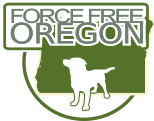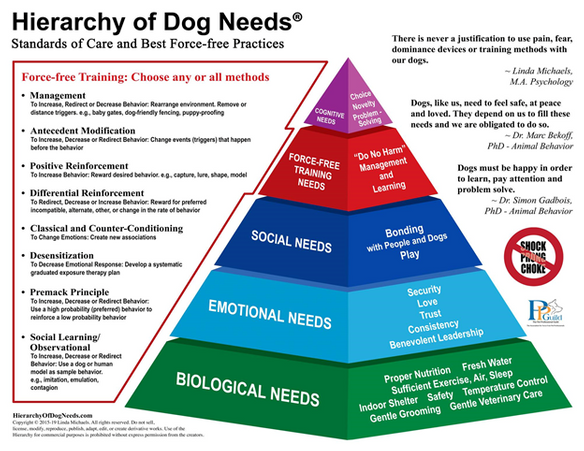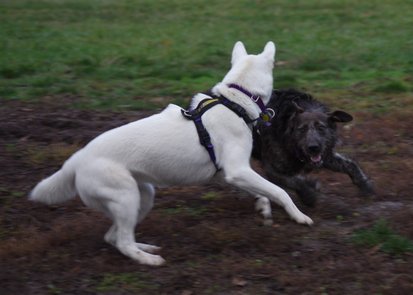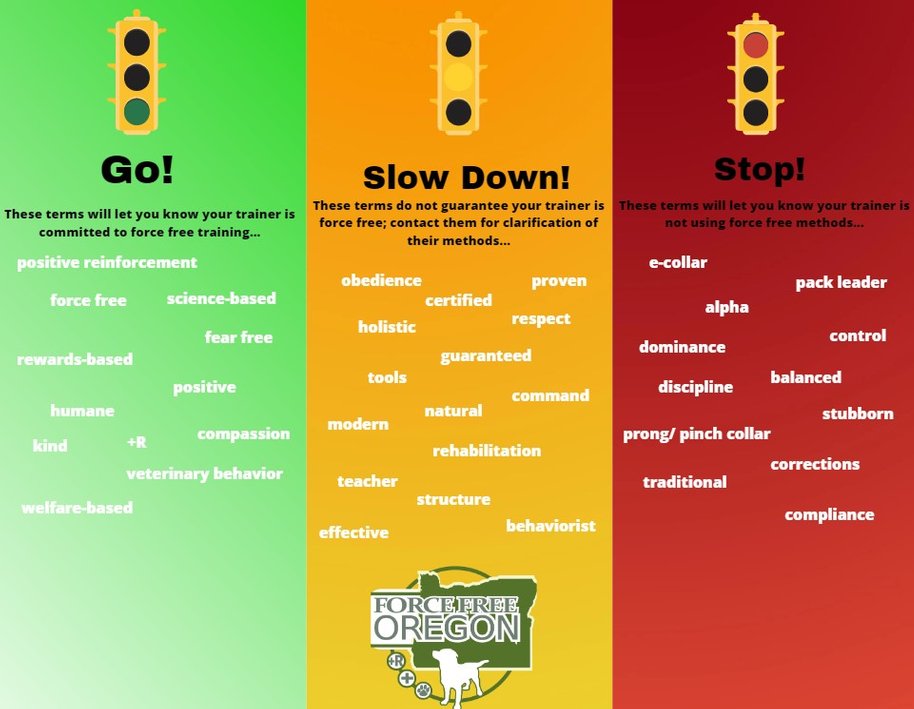Uniting Pet Professionals to Improve Animal Welfare
Over the past 30 years, we have seen great strides in the care and understanding of dogs. The Hierarchy of Dog Needs shown below is a comprehensive summary of the current understanding of our dog’s needs. Pet professionals are tasked with helping us achieve the best possible care for our pets. Every professional whether they are a store clerk, manufacturer of dog products, veterinarian, trainer, or groomer will have either a positive or detrimental impact on our dogs’ lives. One of the primary goals of Force Free Oregon is to provide a directory of trustworthy pet professionals who adhere to Force Free methodology and seek continued learning and professional development. We aim to provide one central place to find Force Free trainers, dog walkers, daycares, veterinarians, and groomers that reside in Oregon.
Why Force Free?
Our dogs need to feel safe, loved, and able to trust us. Force Free methods help our dogs feel safe so that they don’t feel the need to bark, lunge, or bite. Force Free methods help us build our social bond with our dogs while dominance oriented methods detrimentally impact our bond
Research has consistently shown that the use of aversive techniques such as prong, shock, or choke collars have detrimental effects on our dogs' welfare and behavior.
Dr. Karen Overall, Ph.d., a veterinary behaviorist who adopted and treated Flash, a dog that had put 3 people in the hospital before coming to her home, said this in a 2019 paper ” Contrary to popular belief, efficacy data for aversive, punishment-based interventions are lacking. However, studies have demonstrated that adverse behavioral outcomes are associated with punitive training methods among dogs in the general population and dogs seen at specialty behavioral medicine practices.”
In this 2017 paper, the use of punishment-based training was one of the risk factors for euthanasia or rehoming of dogs contradictory to prevailing dog myths. Stanley Coren, Ph.D., discusses the science of using punishment to change dog behavior in this blog. Dr. Zazie Todd’s list of research papers and research related blogs on dog training can be found here. We have provided a shortlist of research papers at the end of this blog.
Why are Biological, Social, and Emotional Needs prioritized Before Training?
Many behavioral problems are a result of unmet biological, social, and emotional needs. We need to address the dog holistically instead of covering up underlying problems with training. When dogs’ social needs are met, demand barking and other attention seeking behaviors decrease. The function of the aggressive displays is to keep scary things away. When we help dogs feel safe, most aggressive displays disappear. Proper nutrition, sleep, and exercise can also go a long way in addressing behavioral problems. Pet stores, groomers, veterinarians, dog walkers, daycares play very important roles in these layers of the pyramid.
But my profession isn't involved in dog training, how does Force Free relate to us?
Unfortunately, many trainers using scientifically backed methods have sent their clients to a veterinarian to rule out medical problems, only to find some veterinarians recommending aversive methods such as shock collars, prong collars, and alpha roles. One of the goals of the directory to help trainers direct their clients to veterinary clinics who will only give scientifically sound behavioral advice and to help veterinarians easily refer their clients to trainers who follow the same Do No Harm ethics. Together we can reduce the number of dogs euthanized for behavioral issues and network together to bring more patients and clients to each practice.
A basic understanding of dog body language and behavior facilitates safer and less stressful veterinary visits for all involved. A fundamental understanding of Force Free methods helps veterinary clinics provide Fear Free veterinary care by learning to prevent fear from developing when possible, to recognize fear, and understand how to address it, and. Small changes can make a big difference.
Force Free Oregon endorses veterinary clinics who have taken time out of their busy schedule to learn how to make veterinary visits less stressful through the Fear Free program or Sophia Yin’s Low Stress Handling. Dr. Karen Overall, DVM, wrote a succinct summary of behavior related research applicable to veterinary clinics in this paper. AAHA behavior management guidelines are another great resource geared toward veterinary clinics. Applying what you learn in these programs can increase your revenue and client retention rate!
Stores
The products you choose to carry, recommend, and the advice your employees give all influence pet parents’ interactions with their dogs. Who you invite to use your store for talks, seminars, and vaccine clinics can have a significant impact on your clientele’ perception of your store, training methods, and experience in your store. Force Free Oregon Stores pledge to avoid carrying and recommending aversive training equipment. When a client asks for behavioral advice, be sure that the advice your employees give is up to date Force Free advice or refer them to a Force Free Trainer. Understanding the fundamentals of Force Free dog training can improve sales by knowing what products the local trainers will be recommending to clients. Providing your staff training in dog body language can reduce the risk of dog bites or fights happening in your store because your staff will be better prepared to know when to step in and intervene. Force Free Oregon has a section in the directory for Force Free professionals available for talks and seminars to make it as easy as possible to select professionals that can be trusted to provide your clients and employees with safe humane and effective information.
Photo Credit: Fang! Pet & Garden Supply
Veterinary Practices
Veterinarians have one of the most challenging jobs in the pet related professions. They are tasked with retaining vast amounts of medical knowledge and diagnosing species that can’t speak to them as well as the emotionally draining task of providing our pets a humane death. Behavioral issues cause the untimely euthanasia of many dogs.
Veterinary practices are often the first to see puppies and often the first to provide behavior advice and having the potential to note and address behavioral problems early. Veterinary care is deeply rooted in scientific medically appropriate interventions: Force Free methods are the scientifically endorsed behavioral interventions.
When Madison Veterinary Hospital changed their behavioral advice from dominance based methods to positive reinforcement and started a Puppy Kindergarten Class they observed that the percentage of dogs that stayed in the home for at least 2 years improved from 33 % to 94% among those who attended the class! Link to source here.
Groomers
Force Free methods make the difference between a relaxed dog, cooperative with grooming, and a dog that is progressively more terrified with every visit and harder to groom. Making a few changes to your routine, learning body language, and how to apply counter conditioning can help dogs become calm and confident.
Happy relaxed dogs lead to better referrals, better client retention, and a less stressful workplace.
Force Free Oregon wants to make it easier to identify great groomers that can help introduce puppies to how grooming can be a pleasant experience and help adult dogs leave fears behind. We encourage groomers to take the Fear Free Groomer Certificate Course. Have a client that needs more help than you can provide? Force Free Oregon makes finding humane trainers easy to find that can help your client overcome fears.
Photo Credit: Do No Harm Dog Training
Dog Walkers
An experienced and knowledgeable dog walker can make a big difference in a dog's life. Many dogs need help learning leash manners. Dog walkers using Force Free methods can rapidly help dogs improve leash manners, making walks more pleasant at both ends of the leash. Force Free training methods help ensure that the dog has a fun and enriching walk.
Understanding body language helps prevent dog bites and is critical knowledge to advising the pet parent as to whether the current walking plan is the best option for their pet. Dog Biz provides some educational resources for dog walkers. See the resources section of this blog for some links to body language resources.
Daycares
Managing groups of dogs so that all dogs have an enjoyable visit requires in depth knowledge and understanding of body language, dog arousal levels, appropriate play interactions, and techniques to successfully redirect dogs in a humane manner.
Dogs can learn practical life skills while at daycare. Force Free methods can greatly ease the redirection of dogs without aversives and prevent unpleasant interactions and displays of aggression. We count on our Force Free daycares to clearly communicate the methods they use with their dogs and how their dogs are doing in daycare. Daycares are not suitable for every dog, but some dogs just need a few changes among play buddies, the environment, or the schedule to greatly improve their experience. Patricia McConnell and Two Brown Dogs have put together this resource.
Conclusion
Every pet professional has the opportunity to help pets live happy and fulfilling lives.
We hope you will join us as we work towards a society where pets are cared for with
scientifically endorsed humane care.
Educational Resources
American Animal Hospital Association Behavior Management Guidelines
https://www.aaha.org/aaha-guidelines/behavior-management/behavior-management-home/
The late Dr. Sophia Yin compiled a complete collection of educational resources for veterinarians, groomers, trainers, and owners. She created the premier resource for handling and restraint in the veterinary setting with as little stress as possible to the animals. https://lowstresshandling.com
Fear Free ® is an educational program that is continually growing and offering new online classes. It is a valuable resource for all pet professionals. https://fearfreepets.com
Dog Decoder is a fun app for learning body language and was produced by Jill Breitner https://www.dogdecoder.com/
Body Language Seminar https://www.dogwise.com/the-language-of-dogs-understanding-canine-body-language-and-other-communication-signals-dvd-set/
Canine Play Behavior
https://www.dogwise.com/canine-play-behavior-the-science-of-dogs-at-play/
Patricia McConnell on Daycares.
http://twobrowndogs.tripod.com/sitebuildercontent/sitebuilderfiles/doggydaycare.pdf
Website for Education for Dog Walkers
https://dogbizsuccess.com/our-mission/
Hierarchy of Dog Needs
http://www.dogpsychologistoncall.com/hierarchy-of-dog-needs-tm/
Position Statements
Kennel Club UK
Pet Professional Guild Position Statements
Open Letter to Veterinarians on Referrals to Training and Behavior Professionals
The Use of Shock in Animal Training
https://www.petprofessionalguild.com/shockcollars
Dominance Theory in Animal Training
https://www.petprofessionalguild.com/DominanceTheoryPositionStatement
The Use of Choke and Prong Collars
https://www.petprofessionalguild.com/chokeandprongcollarpositionstatement
Blogs Discussing the Dog Training Research
References
Bandura, A. (1965). Vicarious Processes: A Case of No-Trial Learning. Advances in Experimental Social Psychology, 2, 1–55. https://doi.org/10.1016/s0065-2601(08)60102-1
Bosch, G., Beerda, B., Hendriks, W. H., van der Poel, A. F. B., & Verstegen, M. W. A. (2007). Impact of nutrition on canine behaviour: current status and possible mechanisms. Nutrition Research Reviews, 20(2), 180–194. https://doi.org/10.1017/s095442240781331x
Burrows, K. E., Adams, C. L., & Millman, S. T. (2008). Factors Affecting Behavior and Welfare of Service Dogs for Children With Autism Spectrum Disorder. Journal of Applied Animal Welfare Science, 11(1), 42–62. https://doi.org/10.1080/10888700701555550
Dodman, N. H., Brown, D. C., & Serpell, J. A. (2018). Associations between owner personality and psychological status and the prevalence of canine behavior problems. PLOS ONE, 13(2), e0192846. https://doi.org/10.1371/journal.pone.0192846
Dreschel, N. A. (2010). The effects of fear and anxiety on health and lifespan in pet dogs. Applied Animal Behaviour Science, 125(3–4), 157–162. https://doi.org/10.1016/j.applanim.2010.04.003
Gazzano, A., Mariti, C., Alvares, S., Cozzi, A., Tognetti, R., & Sighieri, C. (2008). The prevention of undesirable behaviors in dogs: effectiveness of veterinary behaviorists’ advice given to puppy owners. Journal of Veterinary Behavior, 3(3), 125–133. https://doi.org/10.1016/j.jveb.2008.04.004
Guilherme Fernandes, J., Olsson, I. A. S., & Vieira de Castro, A. C. (2017). Do aversive-based training methods actually compromise dog welfare?: A literature review. Applied Animal Behaviour Science, 196, 1–12. https://doi.org/10.1016/j.applanim.2017.07.001
Hartley, C. A., & Phelps, E. A. (2009). Changing Fear: The Neurocircuitry of Emotion Regulation. Neuropsychopharmacology, 35(1), 136–146. https://doi.org/10.1038/npp.2009.121
Haug, L. I. (2008). Canine Aggression Toward Unfamiliar People and Dogs. Veterinary Clinics of North America: Small Animal Practice, 38(5), 1023–1041. https://doi.org/10.1016/j.cvsm.2008.04.005
Herron, M. E., Shofer, F. S., & Reisner, I. R. (2009). Survey of the use and outcome of confrontational and non-confrontational training methods in client-owned dogs showing undesired behaviors. Applied Animal Behaviour Science, 117(1–2), 47–54. https://doi.org/10.1016/j.applanim.2008.12.011
Jagoe, A., & Serpell, J. (1996). Owner characteristics and interactions and the prevalence of canine behaviour problems. Applied Animal Behaviour Science, 47(1–2), 31–42. https://doi.org/10.1016/0168-1591(95)01008-4
Jenkins, E. K., DeChant, M. T., & Perry, E. B. (2018). When the Nose Doesn’t Know: Canine Olfactory Function Associated With Health, Management, and Potential Links to Microbiota. Frontiers in Veterinary Science, 5. https://doi.org/10.3389/fvets.2018.00056
Kang, S., Vervliet, B., Engelhard, I. M., van Dis, E. A. M., & Hagenaars, M. A. (2018). Reduced return of threat expectancy after counterconditioning versus extinction. Behaviour Research and Therapy, 108, 78–84. https://doi.org/10.1016/j.brat.2018.06.009
Luescher, A. U., & Reisner, I. R. (2008). Canine Aggression Toward Familiar People: A New Look at an Old Problem. Veterinary Clinics of North America: Small Animal Practice, 38(5), 1107–1130. https://doi.org/10.1016/j.cvsm.2008.04.008
Overall, K. L. (2019). Evidence-based paradigm shifts in veterinary behavioral medicine. Journal of the American Veterinary Medical Association, 254(7), 798–807. https://doi.org/10.2460/javma.254.7.798
Pires, G. N., Tufik, S., & Andersen, M. L. (2012). Relationship between sleep deprivation and anxiety: experimental research perspective. Einstein (São Paulo), 10(4), 519–523. https://doi.org/10.1590/s1679-45082012000400022
Plaud, J. J. (2003). Pavlov and the Foundation of Behavior Therapy. The Spanish Journal of Psychology, 6(2), 147–154. https://doi.org/10.1017/s1138741600005291
Polo, G., Calderón, N., Clothier, S., & Garcia, R. de C. M. (2015). Understanding dog aggression: Epidemiologic aspects. Journal of Veterinary Behavior, 10(6), 525–534. https://doi.org/10.1016/j.jveb.2015.09.003
Premack, D. (1965). Reinforcement theory. In D. Levine (Ed.), Nebraska Symposium on Motivation. Lincoln: University of Nebraska Press, 13, 189–282.
Premack, David. (1959). Toward empirical behavior laws: I. Positive reinforcement. Psychological Review, 66(4), 219–233. https://doi.org/10.1037/h0040891
Scarlett, J. M., Salman, M. D., New, J. G., & Kass, P. H. (2002). The role of veterinary practitioners in reducing dog and cat relinquishments and euthanasias. Journal of the American Veterinary Medical Association, 220(3), 306–311. https://doi.org/10.2460/javma.2002.220.306
Schulkey, R., & DePorter, T. (2017). Evaluation of the association between attendance at veterinary hospital-based puppy socialisation classes and long-term retention in the home. Retrieved November 22, 2019, from Cabi.org website: https://platform.cabi.org/animalscience/ebook/20173266089
Siracusa, C., Provoost, L., & Reisner, I. R. (2017). Dog- and owner-related risk factors for consideration of euthanasia or rehoming before a referral behavioral consultation and for euthanizing or rehoming the dog after the consultation. Journal of Veterinary Behavior, 22, 46–56. https://doi.org/10.1016/j.jveb.2017.09.007
Taylor, K., & Mills, D. (2007). The effect of the kennel environment on canine welfare: a critical review of experimental studies - The Lincoln Repository. Lincoln.Ac.Uk, 16. https://doi.org/http://eprints.lincoln.ac.uk/9056/1/kennel%20environment%20paper.pdf
Ziv, G. (2017). The effects of using aversive training methods in dogs—A review. Journal of Veterinary Behavior, 19, 50–60. https://doi.org/10.1016/j.jveb.2017.02.004
Can we resolve aggression?
Aggression can be addressed using Force Free methods.
First, it must be understood that aggressive behaviors cannot be "fixed" or "cured"- they can be managed and treated. Additionally, aggressive behavior almost always stems from fear and distress. Addressing these underlying emotions is essential to any successful behavior modification plan.
A trainer knowledgeable and experienced with treating and managing aggression will use a scaffolded approach, starting with environmental management (keeping the dog away from known triggers; possibly muzzle training and other safety measures), building foundation skills related to calmness and communication, and then a careful process of desensitization and counterconditioning to known triggers, at the dog's pace, while keeping the dog below their overreactive stress threshold.
If your dog is exhibiting aggressive behaviors toward humans, other dogs, or other animals, please reach out to a qualified force free professional; aggressive behavior, especially toward humans, can be best addressed by a veterinary behavior professional and their team
Do some breeds need a "firm hand
There is NO breed that needs a "firm" hand, nor does any breed require the use of tools such as shock collars, prong collars, slip leads, or choke collars for training. Force Free methods work for all breeds and for all species. We domesticated and lived with dogs for centuries before these tools were invented, and in fact, every animal on the planet- from whales to tigers to humans to bumblebees- learns through the same principles. How we apply them for each species, and for each individual, can vary.
Many of the behaviors that humans find to be problematic are normal dog behaviors, and sometimes they are behaviors for which dogs have been selectively bred, but they are being expressed out of context. Our responsibility as their guardians is to provide dogs with ways to practice natural behaviors in appropriate environments, and to teach dogs in a kind manner how to live in our society.
Ironically, many of the dogs described as needing a "firm hand" are extremely easy to train through principles of positive reinforcement, as they are eager to work and incredibly clever.
What about alert barking in the home and yard?
One of the reasons humans decided to keep dogs around is because they bark at intruders and tend to defend their territory.
However, some simple management can help decrease barking. You can remove access to the sight of people/ dogs/ squirrels by blocking window access while you are not present to train. A white noise machine, a crate, and baby gates can help keep your dog calmly away from their triggers as well. Ask a force free trainer for help with desensitizing your dog to the sights and sounds your neighborhood.
As for barking at visitors-this is a useful time to train an alternative behavior, which helps give your dog a job, helps them stay calm, and will never accidentally teach your dog that visitors are scary. One of our favorite alternative behaviors to train is "go to your mat" when the doorbell rings.
It is always helpful to bring a trainer in to provide advice tailored to your lifestyle and your dog.
Can we train a reliable recall?
Yes! We train our dogs to happily and voluntarily check in with us regularly, and to LOVE returning to us on cue. Recall is all about relationshiop, and what better way to build a solid relationship than through positive reinforcement?
Recall is an advanced behavior with high expectations. Always start training in a relatively boring environment, like inside your home, to teach the dog that the recall cue is an exciting game. Then move to the least distracting outdoor environment you have available, utilizing either a secure fence or a long line for safety. Reward every single recall, and contionually invest in this behavior throughout your dog's life.
Never let your dog off leash in leash-only areas, and leash your dog if you feel the environment is too distracting or dangerous.
Avoid accidentally punishing a recall. Make sure that the fun does not end when your dog comes back to you. If you recall your dog from playing with another dog, send your dog back to playing repeatedly after they recall. Never punish your dog if they are slow to come back to you. Punishment generally works on the last behavior your dog performed before the punishment was applied. So if they just came back to you, then you punished them for coming back!












